(Editor’s note: This article was written by Stimhack Editor SimonMoon)
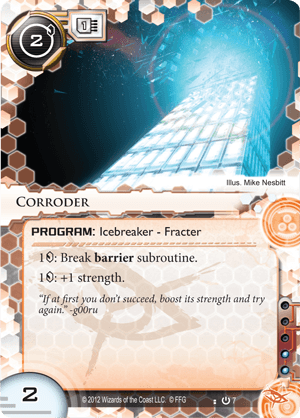
As I talked about in part one the Corporation poses threats and defends them with Ice, the Runner must respond, and we get to everyone’s favorite part of Netrunner: dealing with Ice. Just like a variety of win conditions and threat types are important for a diverse metagame, having there be a variety of ways for Runners to deal with Ice is a core part to a healthy metagame. The most basic tool used for dealing with Ice are Icebreakers. I think it’s important for icebreakers to be a part of dealing with Ice, but I actually think standard boost / break Icebreakers (Zu, Corroder, Garrote) are the least interesting ways of breaking Ice in the game. When they are the most powerful tool for breaking Ice, the effect of Ice tends to get flattened into being Rez Cost / Break Cost once all the Ice breakers are found. This means from the Corporation’s perspective, there tends to be only one avenue of attack against a fully set up runner with standard breakers: tax their money.
However, in terms of what actually gets played, runners bring a variety of supplemental tools or non-standard breakers around their core. Each faction has a couple of tools which define how they approach breaking Ice, and these tools are what give the factions very different feels and makes playing different decks unique. I’ll discuss each faction brief in what I think defines their style and why those cards lead to quality gameplay.
Shaper
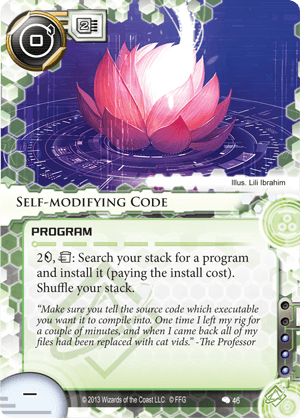
Self-modifying Code (SMC) defines the way in which Shaper attacks Ice in the early game, while Clone Chip defines the way Shaper attacks remotes in the end game. SMC allows Shaper to find the exact tool they need to conquer a given Ice in the early game, while Clone Chip lets them recur powerful and efficient one-off tools to get through remotes efficiently. Often times people dislike the power of recursion in Netrunner, but I find it leads to much more interesting scenarios than we would get without it. The most thought provoking and strongest Shaper deck was Prepaid Kate, whose power was largely based on using Clone Chip in the way I described. This led to many points of decision for Kate, such as do I use this Clone Chip to get out Atman or Sharpshooter? The first option leaves Kate vulnerable on money, the second means I have to use a Clone Chip every time I want to get past the Archer. Or, you might have to trade off on playing a Parasite or a Clot, and you continually have to make decisions about which tool is more important that are non-obvious and not reducible to a single resource.
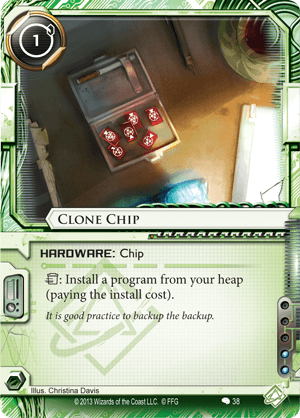
On the Corporation’s side, this meant there were lots of interesting lines of attack against PPK. One game you would find yourself trying to tax out Lady and Cy-Cy with barriers and a constant stream of new code gates. The next you would attack the limited number of Sharpshooters and try to run Kate continually through an Archer as you never advanced an agenda. A third option was trying to tax Kate on her money. The wild thing is you could use all three of these strategies with the same deck against Kate, and it was because Kate utilized predominantly powerful but limited tools combined with Clone Chip that let this happen. Different games resulted in slightly different optimal choices which quickly spiraled out into very different board states. Runner recursion, while powerful, was the driving mechanic behind this because it tends to create a variety of options on both sides above and beyond the simple choice of “Spend X to get into Server Y / N”. The worst kind of Shaper in my mind has always been the Shaper which tries to build up to a powerful fixed rig, because the options and games tend to become very linear for both players as there is only a single resource to worry about – credits.
Criminal
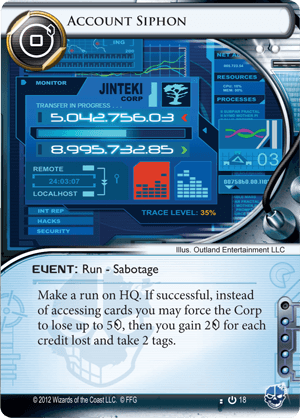
Unlike Shaper, which has efficient tools for every situation and the ability to get them on demand, Criminal in many ways has the weakest Icebreakers. The Criminal strength relies in their powerful events and tools to avoid Ice or counterattack elsewhere. The most iconic of these are Account Siphon and Inside Job. Account Siphon makes it so any Corp facing a Criminal has to Ice HQ first before making any attempt at a score. Simultaneously, the threat of Inside Job means it’s very dangerous to try and score until two Ice are on the remote. Any scoring possibility against Criminal therefore requires large amounts of build up. Because scoring took so much build up, Criminal is able to find its own tools and fully set up before the Corp is able to score. The Criminal downside of their relatively weak Icebreakers plays against their run-based economy, making them vulnerable to Glacier and taxing Ice.
What makes Criminal exciting and different isn’t so much their one-shot programs. Rather, the event based tools they have to disrupt the Corp (Shutdown, Siphon, Inside Job, Sneakdoor) leads to a lack of inevitability in the late game. Breakers such as Passport, Faerie, and Femme come with interesting restrictions and strengths which also gives the Corp counterplay. While this has primarily been about breaking Ice, it’s important to note the strength of run-based economy (Desperado, Testing, Temujin) in Criminal leads to very difficult trade-offs on where to defend on the Corp side. Deciding where to place Ice against Crim involves lots of negotiation between your own economy as well as your short-term and long-term defense. At different points in Netrunner’s history the ability of Criminal to control Corp development has been too great and they were simply able to snowball the early game and never lose control. That is the danger of Criminal, though it has been very well designed around, and the importance of Resources to them has been a great design choice to lessen the power of Siphon.
Anarch
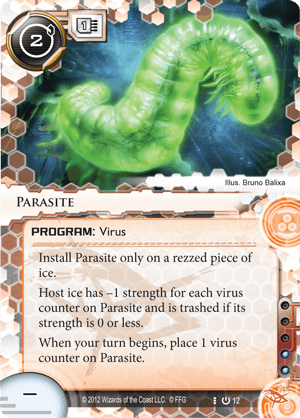
Although recently Criminal has risen up to be at a similar power level, Anarch has been on top for a while. The core of the traditional Anarch breaker plan has been Parasite and Datasuckerand working around the weaknesses of their fixed breaker suite. Unlike the other runner factions, Anarch has no built in icebreaker tutoring, which slows down their setup time and means they are often unable to find the exact answer they need. Instead of being able to get the breaker they want, they utilize Parasite as a one time only emergency breaker that can plug the gaps in their breaker draw. Additionally, Parasite also acts to give them late game power by allowing them to permanently destroy expensive Ice and reduce the run cost of expensive servers. This comes with some drawbacks, however: they often need to facecheck Ice before it can be Parasited, meaning Ice subroutines fire way more against Anarch (besides Faust) than any other faction. Ice like Cobra and Komainu are considered for their trade-offs between firing potential and their vulnerability to Parasite.
Additionally, the decision about what Ice to Parasite tends to be a very challenging one. The Runner can hold your Parasite to use on a more expensive stronger Ice, but that doesn’t solve your issue with the cheap gear check. You often have to decide between making a central easy to access versus threatening the remote. Datasucker adds another interesting layer of play to these decisions. Since Datasucker requires central accesses, it gives the Corp a great deal of counterplay against the Datasucker + Parasite combo, as every deck is packing a toll to counteract Datasucker: Ice). The Corp need to decide whether to allow Anarch to have free reign over centrals, or if they want to slow down their own game and use Ice to lock down Datasucker (often forcing the Parasite to be slow rolled or used on a cheaper Ice). The dynamic of Parasite and Datasucker leads to hard decisions and trade-offs between protecting or attacking various servers and the long and short term value of the play on either side. When Anarch goes bad, it’s when their Ice destruction becomes too plentiful and there ends up being no meaningful decisions on either side as every Ice is destroyed on rez. I do not believe this is the current state of the meta, but Sifr has created problems because it destroys the Corporations control over Parasite’s ability to destroy Ice.
Lessons of Faction Power Cards
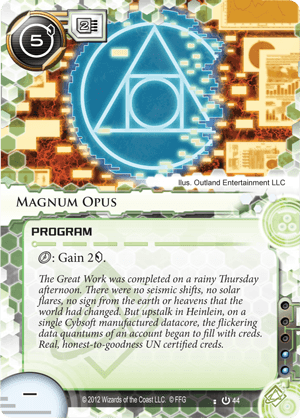
All the faction defining cards above are powerful cards well above the curve. As oppressive as these cards may sometimes feel, the game is more interesting when these are the power cards instead of cards like Underworld Contacts or Gordian Blade. In a metagame where the most powerful means of breaking Ice is a general all-purpose breaker, or recurrable econ is incredibly powerful, you end up with every game being very similar. The plays available end up being the narrow decision between running any given server for X dollars. Compare this against a situation that involves deciding if it’s worth it to pay three credits to Run through an Eli for a Datasucker counter to destroy an Ice a turn sooner. All of these powerful tools for dealing with Ice create decision points far more challenging than the standard ice breakers.
One deck worth talking about in particular is Noob Kit. This is a great deck! Despite using Gordian Blade and Magnum Opus, it also uses Test Run, Scavenge, Femme, and Lady (as well as Stimhack and Personal Workshop). This deck has several resources to consider when breaking Ice, and its breakers are too generally inefficient to remote lock without consideration to Femme placement. When you’re trying to challenge the Remote, you’re trying to force your opponent to place enough resources there in order to score that you can counter attack elsewhere. You have all sorts of tricks and tools which make the Corp need to pay attention to how you’ve played in order to figure out which ones you have access to. It has a variety of resources for both sides to consider, and its gameplan is not overly linear against a single server and relies heavily on what the Corp leaves vulnerable.
Deckbuilding Impact of Faction Power Cards
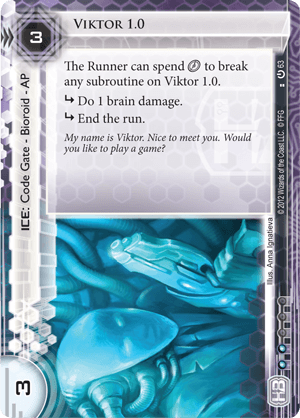
The other large impact of these power cards is in deckbuilding. Despite its reputation, Parasite does more for diversifying Ice selection than any other card. The truth of the matter is that other than a couple of completely busted cards (Eli, FC3), no Ice has been universally good against every breaking option. Some Ice are good against Parasite and bad against regular Icebreakers (Lotus Field, Magnet, Little Engine). Some Ice are bad against Parasite and good against regular breakers (Tsurugi, NEXT Ice). Some Ice are good against Parasite and regular breakers, and bad against Link (Assassin, Sherlock 2.0, Macrophage). This difference in quality against different solutions is not only okay, it’s what leads to diversity of Ice!
I played Foodcoats over the course of a year and I was constantly changing the Ice I was using as my expectations for the Runner meta changed. Did I get mad when Yog came back and Viktor 1.0 and Fairchild 2.0 became less strong? No! Instead I got to try using Ravana, Magnet, and Fairchild 3.0. Without Yog and Parasite there are only four relevant code gates in HB: Fairchild 2.0, Fairchild 3.0, Ravana, and Next Bronze. As the meta shifted over the course of the year I played the following code gates: Magnet, Turing, Fairchild 2.0, Fairchild 3.0, Ravana, Viper, Enigma, and Tollbooth as my expectation for what code gate breakers I would face changed. Compare this to my barriers which stayed at 3x Eli the entire year, as this was simply the best against the expected barrier Breakers: Corroder (then Paperclip), Faust, and Lady. What largely drives Ice diversity in code gates and sentries is the diversity of breaking options that barriers lack (though NBN tended to have the most interesting considerations when deciding between Resistor, Wraparound, and Vanilla which all have strengths and weakness against various alternative breaking options).
If you try to enforce a meta where standard breakers are best by lowering the power of one-off programs and recursion, you end up in a situation where Ice becomes a function of three things: gear check, face check punishment, break cost. Instead, what we want are situations where we have those things and more! The game is best when you’re figuring out if you’re too vulnerable to Parasite, Atman, Link, and Sharpshooter and trying to balance out your weaknesses to each. Deck building for Ice is most intriguing when the Runner meta is faction diverse, and each faction is using their own style of breaking rather than everyone trying to use the same best regular breaker (or the strongest in-faction breaking options operates the same way in every faction).
When Non-Standard Options Go Awry

Now, while I think the game is at its best when non-standard breaker options are the strongest, it should also be noted there have been failures (and currently multiple failures) in designing non-standard breaking options. The biggest two are DDoS (in Dyper) and Blackmail, which rather than making different aspects of Ice matter more or less, they cause all Ice to be equivalent since they’ll never be rezzed. From the Runner perspective, Blackmail tends to take away any choice other than Blackmail or do not run, because you cannot afford to let Ice get rezzed. The biggest takeaway is that any alternative means of dealing with Ice should care about what the Ice says. Inside Job, as opposed to Blackmail, still differentiates between Vanilla and Curtain Wall when being passed, and leads to important decisions about where to place Ice when defending against it.
The other major icebreaking failure is Faust. AI breakers work when they either supplement the main breaking suite (Atman, Knight) or have a severe restriction which creates a different dynamic (Atman, Eater). Some people think Faust falls into both these categories, but the truth is Faust is the most efficient Icebreaker in the game and its drawback (needing cards) is trivial to build around. There end up being less than ten Ice in the game that Faust breaks less efficiently than other options (Wraparound, Turing, Swordsman, Komainu, Brainstorm), as it scales incredibly well for Big Ice with two strength boosted per card. You end up barely needing to supplement it with three orfour cards to effectively break every Ice in the game (2-3 Parasites, 0-1 Mimic, 1-2 D4vid). The Faust synergy with Cutlery only adds to its power.
A lot of people like that the Cutlery requires breaking Ice, but I actually think that makes them worse design. Where Parasite and Datasucker create a new economy to be considered, Cutlery acts to reinforce the standard economy and make the game more snowbally since it reinforces the binary nature of Found Ice Breaker : Yes / No. Parasite gives you a different axis to measure Ice along, whereas Cutlery still makes you think of Ice purely in break cost. The gameplay itself is okay, as Cutlery requires you to think about long and short term trade-offs between Ice position and rezzing. I think Cutlery is well designed when combined with Eater, as it acts as a secondary breaker that allows Eater decks to actually access cards. It becomes way more viable to only rez the innermost Ice and protect it with unrezzed outer Ice than it does against Faust, as Faust is perfectly happy to run through a one Ice deep server. Faust is a lesson in making sure AI breakers are actually less efficient than normal and also making sure your drawback is an actual restriction. Basically every strong deck that Faust has been in has been degenerate in some fashion (DLR Val, Dumblefork, Noise, Hate Bear), and as printed is a huge design mistake that should be gotten rid of. I do think the idea of Breaking with cards is solid design space that can leads to quality gameplay, but Faust is simply several orders of magnitude too powerful and and needs to be more restricted (less efficient or not being an AI).
Conclusion
I don’t think anyone who loves Netrunner does not love the mechanic of running. It’s my second favorite mechanic in the game behind milling cards with DLR, and I think the joy of running is largely on the back of the diversity of solutions to Ice. Oftentimes cards like Parasite, Yog, Clone Chip and Account Siphon are accused of ruining real Netrunner, but I think the truth is that I think they are way more interesting and way more fun to play with and against than only having decks with one to boost one to break Icebreakers. Sure, they are all slightly undercosted, but I think the game is far better with them in the game and undercosted than if they were not in the game at all. They allow for a massive degree of choice both in deckbuilding and within the game of Netrunner itself, and I think these power cards are responsible for a significant chunk of what makes Netrunner a great game.




